#hospital management software providers
Explore tagged Tumblr posts
Text
A hospital is a center of activity, from medical and administrative tasks to financial and legal functions. While everything under this was once done manually, the HMS or hospital management system has been nothing short of a revolution.
The adoption of Hospital Management Software has ushered in a transformative era for the healthcare sector. It is bringing in streamlined operations, robust data security, and optimal patient care. These systems are no longer just a luxury but a necessity, enabling medical facilities to stay ahead in this technologically driven age.
At EMed HealthTech, we pride ourselves on being at the forefront of this revolution. Our seasoned team of healthcare UI/UX web designers brings their vast experience in crafting healthcare websites that are not only innovative but also error-free. Before delivery, we rigorously test our designs, ensuring they meet the latest industry standards. Our solutions ensure that you have increased patient engagement and streamlined operations.
0 notes
Text
How healthcare providers reputation affects patient’s decision?
With easy access to online searches and other modes of finding a reliable healthcare provider the life of the patients have undergone a massive change. Not only does the patient has more and wider options to choose a healthcare provider but this transformation has also brought unforeseen change in the decision-making ability of the providers.

A physician's reputation has a significant impact on their ability to draw in and keep patients in the always-changing healthcare industry. One of the most important factors in forming the patient once they are cultivated is the doctor's reputation. A doctor's reputation affects their digital presence and patient outreach even outside of their office, in a time when word-of-mouth recommendations and internet reviews carry a lot of weight. Since reputation management directly affects patient impressions, trust, and eventually a medical practice's success, it is critical to comprehend the significant ramifications of this discipline in the healthcare industry. In this introduction, the vital role that reputation plays in determining a doctor's patient following is examined, along with the complex processes that support this essential component of contemporary healthcare delivery.
These days software and applications developed to facilitate the work culture of the healthcare providers are working as a great support. Many applications and software are facilitating the online reputation management for doctors that helps to establish an image and builds clientele.
The recent researches indicate that more than 70percent of the patients opt for the online mode for checking the reviews and the ratings of the providers before making a decision. Let's understand the reasons which factors are essential to establish an image of a provider and how it can affect the rapport building.
Developing a reputation and growing a patient base for a healthcare practitioner requires several key elements:
Clinical excellence is the delivery of excellent healthcare and the demonstration of mastery in the identification and management of medical disorders. Patients look for medical professionals that are competent, experienced, and able to treat them effectively.
Patient-Cantered treatment: Giving patients' wants and preferences top priority while providing them with individualised, empathetic treatment encourages loyalty and trust. Strong patient relationships are fostered by healthcare professionals that actively include patients in decision-making and show empathy while addressing their problems.
Communication Skills: Developing a good reputation requires effective communication. Healthcare professionals should listen intently to patients' worries, speak effectively, and provide straightforward explanations of medical information. Collaboration and the development of trust between patients and providers are facilitated by effective communication skills.
Availability and Accessibility: A healthcare provider's reputation is improved by being reachable and attentive to patient demands. Providing easy ways to schedule appointments, prompt answers to questions, and after-hours availability shows that you care about the needs and happiness of your patients. Online Presence and Reputation Management: In the current digital era, upholding a positive online image and controlling online reviews and ratings are crucial. In addition to regularly monitoring and replying to patient feedback, healthcare providers ought to interact with patients on social media and use online platforms to highlight their accomplishments and areas of expertise.
Empowering Patient Education: Giving patients access to trustworthy health resources and information enables them to decide on their own care. Healthcare professionals who use educational materials, seminars, or internet resources to empower and educate patients improve their standing as reliable sources of medical information.
Collaborative Care Approach: A comprehensive approach to health and wellbeing is promoted by working together with other medical professionals and specialists to coordinate patient care. Prioritising interdisciplinary teamwork allows healthcare providers to show their dedication to providing comprehensive patient care, which improves their standing with both patients and colleagues. By concentrating on these elements, medical professionals can establish a solid reputation, raise patient satisfaction levels, and draw in a devoted clientele of patients who respect and trust their services.
Reputation management advice: In today's world, the majority of patients are swayed by the opinions and assessments of their fellow patients. As such, they make sure that the provider has positive feedback and high ratings prior to scheduling an in-person appointment. Therefore, it is important for providers to be online as well. By enhancing their online image, physicians can attract more patients by implementing the following techniques:
Encourage pleased clients to write favourable reviews: Encourage happy consumers to leave positive reviews on popular review websites such as Google My Business, Healthgrades, and RateMDs. Give patients detailed instructions on how to submit reviews, and express gratitude for their participation.
React to Reviews: Be aware of and respond quickly to both positive and negative patient reviews. By replying to patient remarks, you show that you value them.
Disseminate Educational Content: Distribute instructive and educational materials. Offer Educative stuff: Post enlightening and instructional stuff on your social media pages and website. To establish yourself as a thought leader in your industry, write blog articles, make videos, or conduct webinars on subjects related to your area of expertise. Keep Up an Interesting Social Media Presence: Use social media sites like Facebook, Twitter, and Instagram to interact with patients and post insightful information. In order to promote a feeling of community and connection, swiftly respond to questions and remarks from patients. Optimize Online Listings: Make sure that all of your platforms' online listings are correct and current. To facilitate patient finding and communication, this involves changing your contact details, office hours, and services provided.
Engage Influencers in Partnership: To broaden your audience and boost your online presence, team up with prominent figures in the community or the healthcare industry. Working together can help you get more referrals and improve your standing in the community.
Invest in Tools for Online Reputation Management: To monitor, assess, and enhance your online presence, think about spending money on tools and services for online reputation management. These tools can help you pinpoint areas that need development and offer insightful information on patient sentiment.
Doctors may attract new patients, build long-term patient loyalty and trust, and improve their online image by putting these methods into practice.
In the eyes of potential patients, these reviews and ratings are important markers of a provider's standing, dependability, and standard of care. In order to foster pleasant experiences that result in positive evaluations and ratings, healthcare practitioners should prioritise patient satisfaction, communication, accessibility, and clinical excellence. Furthermore, cultivating a robust and credible presence in the healthcare community is facilitated by actively managing one's online reputation, interacting with patients, and persistently working to enhance patient care. In the end, higher evaluations and ratings not only draw in new clients but also improve client loyalty, trust, and general satisfaction, strengthening patient-provider bonds and improving healthcare delivery outcomes. If you are dealing in healthcare sector, or running a clinic Ziaccu can help you in establishing an image we focus on the Online reputation management for doctors with our software and consequently contribute in the better image building for your healthcare institution.
#increase patient engagement#outsource medical billing services#medical billing for providers#clinic management software#emr billing system#hospital billing software#radiology billing software
0 notes
Text
Enhance Your Business Efficiency with EPOS Solutions

Revolutionize your business operations with advanced Electronic Point of Sale (EPOS) solutions offered by Euroland IT Store. Explore our comprehensive range of cutting-edge EPOS systems tailored to meet the specific needs of your industry. From retail to hospitality, empower your business with efficient and intuitive point of sale technology from Euroland IT Store.
#Point of Sale solutions#EPOS hardware#EPOS software#Sales management#Hospitality POS systems#EPOS system providers
0 notes
Text
5 Steps to Rebuilding & Maintaining Guest Trust
In the ever-evolving landscape of the hospitality industry, guest trust is the cornerstone of success. Building and maintaining trust is a delicate dance that requires constant attention and adaptability. Understand the top five crucial steps to rebuild and sustain guest trust, with a special emphasis on the implementation of Property Management System (PMS) software.
0 notes
Text
Streamlining Healthcare Excellence: HMS Software Solutions for Efficient Management
HMS (Hospital Management Systems) software providers specialize in developing and offering software solutions tailored for healthcare management. These systems are designed to streamline various aspects of healthcare administration, including patient information management, billing, scheduling, and overall workflow optimization. HMS software aims to enhance the efficiency and effectiveness of healthcare organizations by providing tools for accurate record-keeping, financial management, and compliance with regulatory requirements.
0 notes
Text
Hospital Management System is a platform or software that ensures that all the daily activities and interactions that happen in the hospital or clinics work smoothly. It monitors hospital operations, patient data management, legal and financial controls, bills, etc.
We are outfitted with a tremendous talent pool of developers and designers who have proved their contribution to the field of development by deploying 2200+ projects in the span of two decades. If you are seeking to avail of such services you can contact us.
#healthcare service providers#Healthcare Software Development#Hospital Management Software#healthcare app development company
0 notes
Text
More random info and pictures of the Kerch Polytechnic incident, mainly small details regarding Vlad.
home



His house and room. He grew up in Arshintsevo before moving somewhere else in Kerch, Crimea with his mother after his parents split up. He was living in poverty, since the only direct provider was his mother, who was a nurse and oncologist at a nearby orderly hospital.
ammo and gun training


The ammo he used for the attack. He used birdshot and buckshot pellet bullets. On July 18th 2018, he went to Egida Training Centre to apply for gun training.
Accordining to an interview user Skanderarrent2 posted on reddit, his trainer mentioned that he was skilled in shooting and initially thought that he had experience with firearms:
“Because he spoke very confident, self-collected. I felt that he was more mature in his soul than (an) 18 year old. It felt that he was a young adult, not a teenager, not an 18 year-old because he did everything clearly. Some people are verbose, but he didn’t have extra words, was silent. And he didn’t ask too many questions. I had the impression that he quickly learned, etc. That is, he created the impression of a trained person. The teachers noticed that he shot well, when asked where he learned why he shot so well, the young man replied, ‘I practiced shooting’”
The taining which included 4 hours in theory and 2 hours practice, cost Vlad 4,000 rubles or $62 instead of 6000 or $93. He said he had financial difficulties, and the management gave him a discount. He then subsequently earned a license and bought a gun from Oruzheinik Gun Shop during August of 2018.
purchase history and materials


His purchase history up until the attack and what he had bought and wore during the attack. People speculate that he hand-painted the "ненависть" on his shirt.
handwriting

an assignment he wrote regarding electrical safety. a rough translation of his assignment reads:
“Mapogon or an order defines the boundaries of the workplace, the volume of work performed, the scope of the work, as well as the list of employees who are responsible and perform the work. Unauthorized carrying out of work and white changes in people's permission instructions are strictly prohibited. If the work performed in an electrical installation involves the use of (unintelligible) mechanisms, then 4 technological steps are necessary KAPTAM - according to specially developed software. When performing work on electrical equipment up to 1000 V, the MO should be directly energized. Install fences for nearby live parts to which K work is carried out. accidental contact is possible when performing acidental...”

extra. why he standing like dat?? had to tip a toe
79 notes
·
View notes
Text
Lessons in Japanese Game Design #3

From Killer7 to Deadly Premonition, Japanese game creators have intrepidly explored the theme of mental illness in a variety of genres, often in highly stylized form. The title I wish to approach today is a lesser known reference that approached this subject matter with unusual tact and clarity - a memory, if you will, which the collective conscious has long repressed.


Maria Kimi Tachi Ga Umareta Wake (The Reason You Were Born) is a late 1997 adventure game firmly rooted in the visual novel template that earned Chunsoft great repute. It was Break studio's debut, produced over a year and half for both the PlayStation and Saturn systems. It was published by Axela, a company born out of the internal management conflicts and accumulated debt at ASCII, leading to some of its executives teaming up in 1996 to establish a new project centred around software and magazine publishing. The story of this company's origins, alone, would merit a separate post.
Foreseeably, its release was followed by moderate controversy, such that worked mostly in its favour. One of the most polemical moments is found in the introduction scene, with its tasteful yet unvarnished depiction of Maria's suicide attempt, followed by her hospital admission. The imagery and that which it depicts remains as painful to watch today as it did decades ago.
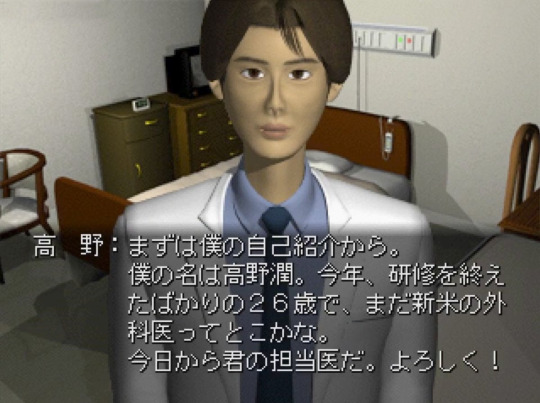
While Maria is the central character, her tragedy and arc merge with that of the actual protagonist, Jun Takano, a fledgeling surgeon who, in the quality of certified psychiatrist, is assigned to provide therapy to the French-Japanese patient the morning after her admittance.



Maria's mental illness component comes to light as the story and therapy sessions progress. The key art consists of photos of women using coloured masks to visually represent the dimensions of her multiple personality disorder.
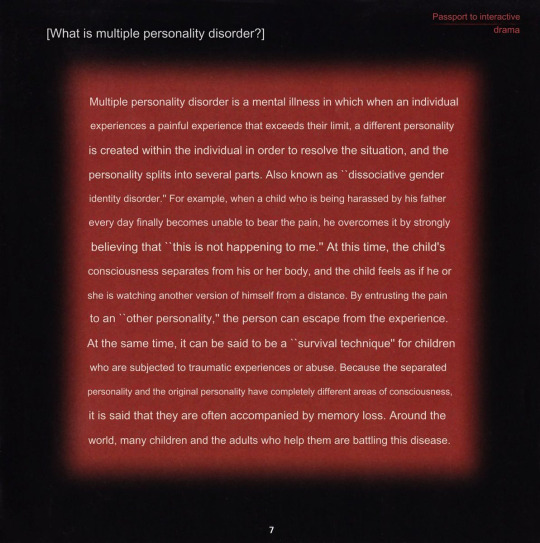
(Note: the text above is machine translated from the original Japanese game manual.)
Break was denounced for its bid to integrate so serious a derangement as a theme in a juvenile entertainment piece. Their reaction was to highlight the research done to ensure a careful treatment of the subject and sensitization of players via a bespoke message in the manual. In retrospect, the relative popularity of this game at the time was greatly owned to this fleeting controversy, and is believed to have been a crucial factor in the obtention of budget for Maria's far less spirited sequel.
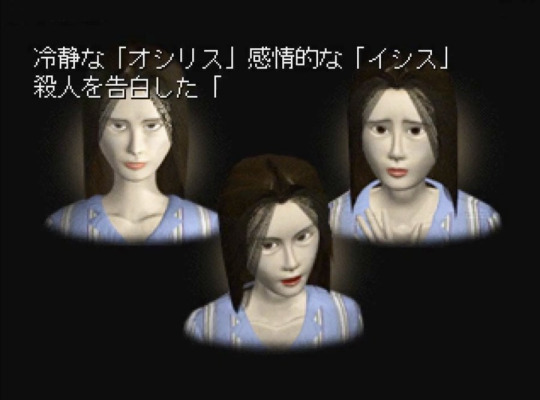

As a work of pure fiction, scenario writer Kirie Fukuda was at liberty to carry the already divisive premise into even more exotic territory by establishing a mysterious yet playful correspondence between Maria's distinct personas and Egyptian deities.
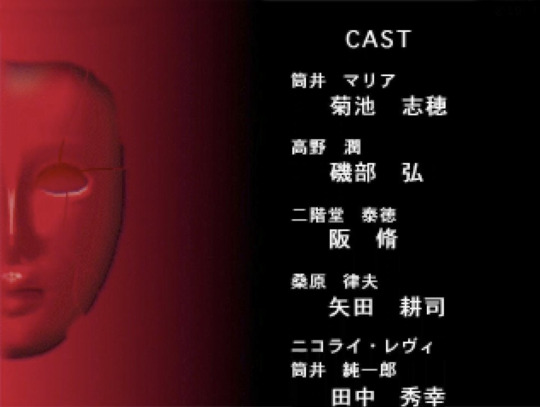
The game's structure is modelled after hirudorama, a Japanese word interchangeably used to describe daytime TV fiction or soap operas; each of its nine chapters lasting nearly thirty minutes, equipped with a plot twist, cliff-hanger ending, and followed by rolling credits.

Perhaps the single most outstanding aspect about this production results from a tireless effort to surpass the standard of authenticity in what pertains facial expressions; particularly those of the multifaceted Maria, often with stilted yet all the more fascinating results.

In this and other regards, the influence of D no Shokutaku and its character, Laura, is clear and unmistakable. Maria's director and studio head at Break, Akira Okada, was an ex-Warp employee who worked as sales director precisely at the time when Eno's game was being developed.




Following a modest success, Break released Maria 2: Jutaikokuchi no Nazo in 99, a not-so-direct sequel which did not command the same attention as the original. The studio created other noteworthy visual novels: Ouma ga Toki and its sequel, as well as the most unusual Saishuu Densha, a paranormal-themed romantic story involving two strangers who meet in a train.


Before closing, it would pay to emphasize that this is an entirely different adventure game from the similarly forgotten MA-RI-A Ningōkan no Noroi, a 1996 3D CG horror adventure designed by Osamu Tezuka's son, Makoto; and scored by Kuniaki Haishima, of Kowloon's Gate and Siren 2 fame.


Nor is it related in any way with the so-called "Maria" episode from the Yarudora visual novel game series, Sampaguita, released in 1997 for the PlayStation by Sugar & Rockets and Production I.G.
#Maria Kimi Tachi Ga Umareta Wake#obscure japanese games#japanese game design#mental illness#suicide#axela#break#playstation#saturn
71 notes
·
View notes
Text
New Gaza fundraiser asks I've received (26 August)
Ayman Sharif (@aymanelsharif): Ayman has 6 children. His child Mohammed (6) has a problem with his eyesight and is at risk of losing his vision if he doesn’t get surgery soon! However, since all the hospitals in Gaza have been destroyed, they will have to go to Egypt to get the surgery he needs. A lot of children children are also contracting hepatitis due to the unsanitary environment and they have all lost a lot of weight. Please help them evacuate! (https://gofund.me/0ff8b798) (#244 on the verified fundraiser list by el-shab-hussein and nabulsi.)
Jawad & Farouz (jawad236): Jawad and Farouz have two children: Muhammad (4) and Ahmed (10 months old). Their home has been destroyed, they have lost their source of income, and are now displaced. They are raising funds to buy daily basic necessities, medicine, shelter, evacuate and start a life in a new country. (https://gofund.me/bc231514) (#655 on the Butterfly Effect Project verified campaign list.)
(@falestine-yousef)
Mohamad Smeer (@mohamadsmeer34): Mohamad is a palestinian medical student studying in Egypt right now. He has lost contact with his family since October 7 and his house has been bombed. He is trying to raise funds to cover his studying expenses. (https://gofund.me/db622b3a) (UNVETTED but seems legit. This is his Instagram: @mohamadsmeer and it has links to the same gfm campaign. His Instagram has been active since 2017 and he has posts that are geotagged in Gaza.)
Rawan Shihada (@rawanshihada11): Rawan lives with her parents and 4 siblings. She is a renewable energy engineer, graduated in 2022 and already has a published paper. She dreams of doing a master’s degree. However now their home is destroyed and they have been displaced 6 times. Her brother Karam is a medical doctor, her sister Ruba is a software engineer, and her youngest sister Tala is 17, a secondary school student but the war has obstructed her education. They are trying to evacuate out of Gaza. (https://gofund.me/741d42ef) (UNVETTED but likely legit, see post here. @/catboymoses has managed to find Rawan on both LinkedIn and ResearchGate and has messaged her to confirm that this is her Tumblr account and fundraiser.)
Falestine (@falestine-yousef): Falestine has a 3-month-old son called Youssef that she gave birth to during this war. She cannot provide enough milk, medicine and other basic necessities for the baby. Due to the horrible conditions and the loss of their homes, her father suffered a stroke and her mother is suffering from chronic diseases and needs treatment. They are raising funds to evacuate out of Gaza and buy daily necessities. (https://gofund.me/77ca82d7) (shared by 90-ghost) (additional info on Falestine and her sisters)
Click here for my Masterlist for fundraisers from 13 July - 25 July.
Click here for my Masterlist for fundraisers from 26 July -29 July.
Click here for my Masterlist for fundraisers from 30 July - 1 August.
Click here for my Masterlist for fundraisers from 2 August - 5 August.
Click here for my Masterlist for fundraisers from 6 August - 10 August.
Click here for my Masterlist for fundraisers from 11 August - 14 August.
Click here for my Masterlist for fundraisers from 15 August - 18 August
Click here for my Masterlist for fundrasiers from 19 August - 21 August
Click here for my Masterlist for fundrasiers from 22 August - 24 August
How does vetting and verification work? See post here. (also read comments regarding 90-ghost and why we trust the campaigns he has shared)
Click here for my Google Doc with my complete masterlist of all the Palestinian gfm asks I've received, updated daily (along with other verified ways to send aid to Gaza).
Don't forget your Daily Clicks on Arab.org, it's free!!! and Every click made is registered in their system and generates donation from sponsors/advertisers.)
#palestine#gaza#free gaza#free palestine#post has been vetted and verified#verified#gaza genocide#vetted#donations#fundraising#vetted gfm#vetted campaign#vetted fundraisers#vetted gofundme#verified fundraiser#verified gofundme#gaza fundraiser#gaza gofundme#palestine gofundme#palestine fundraiser#gaza gfm#palestine gfm#new ask#new asks#26 august
36 notes
·
View notes
Text
Hospital Management Software: Transforming Healthcare with Grapes IDMR
Author : Jerald Nepoleon
In the dynamic healthcare landscape, technology plays a crucial role in streamlining operations, improving patient care, and reducing administrative burdens. Grapes IDMR, a leading provider of hospital management software, offers cutting-edge solutions designed to elevate hospital efficiency and ensure seamless management across departments. With the rise of digital transformation in healthcare, implementing a robust hospital management system (HMS) is no longer an option but a necessity. Let's explore how Grapes IDMR’s software stands out and drives excellence in hospital administration.

Why Hospital Management Software Matters
The primary objective of any healthcare facility is to provide superior care to patients while maintaining operational efficiency. Managing multiple departments, scheduling, billing, inventory, and patient records manually is time-consuming and prone to errors. Hospital management software simplifies these processes, offering a unified platform for tracking every aspect of a hospital’s operations, from patient registration to discharge.
In an era where patient care and experience are paramount, hospital management software optimizes workflows and ensures that healthcare providers can focus more on patients and less on administrative tasks. Here's where Grapes IDMR makes a remarkable difference.
Grapes IDMR Hospital Management Software: A Game-Changer
Grapes IDMR’s hospital management software is a complete, integrated solution tailored to meet the unique requirements of modern healthcare institutions. By bringing together various modules such as appointment scheduling, patient management, billing, reporting, and inventory control, Grapes IDMR offers a seamless and intuitive platform. Here are the key features that make it a preferred choice:
1. Patient Information Management
Managing patient records, histories, test results, and appointments can be challenging, especially for large hospitals. Grapes IDMR's hospital management software provides a central database for storing and retrieving patient data with ease. This ensures timely access to critical information, improving decision-making and patient care.
2. Appointment and Scheduling
With a highly intuitive scheduling system, Grapes IDMR helps hospitals reduce waiting times and optimize doctor appointments. The system allows real-time updates, ensuring that doctors, staff, and patients are aligned, reducing chances of overbooking or under booking.
3. Billing and Payment Integration
Hospitals deal with multiple payment methods and insurance claims on a daily basis. Grapes IDMR simplifies the entire billing process by providing automated invoicing, payment reminders, and integration with third-party insurance systems. This reduces billing errors and accelerates the payment cycle.
4. Inventory and Supply Chain Management
Efficient management of hospital inventory is vital for preventing shortages and ensuring that essential medicines and supplies are always available. Grapes IDMR’s hospital management software offers an automated system that tracks inventory levels, alerts on reorders, and ensures that the right supplies are always stocked.
5. Data Security and Compliance
One of the critical concerns in healthcare is data security. Grapes IDMR takes this seriously by offering state-of-the-art encryption and security measures that protect sensitive patient data. Additionally, the software is fully compliant with healthcare regulations, ensuring that hospitals adhere to industry standards and legal requirements.
6. Reporting and Analytics
Having access to real-time data and analytics is crucial for making informed decisions. Grapes IDMR offers a comprehensive reporting module that provides insights into hospital performance, patient outcomes, financial metrics, and more. This allows hospital administrators to track key metrics and identify areas for improvement.
Benefits of Implementing Grapes IDMR Hospital Management Software
Integrating hospital management software like Grapes IDMR into your healthcare facility comes with a wide array of benefits:
1. Improved Patient Care
By automating routine tasks, doctors and healthcare professionals can focus more on delivering high-quality care. Grapes IDMR ensures that patient data is accessible at the click of a button, allowing for quicker diagnoses and treatment plans.
2. Increased Efficiency
With automated scheduling, billing, and inventory management, hospitals can optimize their operations, reduce redundancy, and increase staff productivity. This not only saves time but also cuts operational costs.
3. Enhanced Communication
Grapes IDMR enhances communication between departments and medical staff, ensuring that everyone is on the same page. This is especially useful in critical situations where time-sensitive decisions are required.
4. Cost Savings
By automating various administrative tasks, hospitals can significantly reduce overhead costs. Billing errors, scheduling conflicts, and inventory issues are minimized, leading to overall cost savings.
5. Data-Driven Decisions
Grapes IDMR’s powerful reporting tools enable hospitals to make data-driven decisions, improving both patient outcomes and financial performance. The software provides valuable insights that can help in resource allocation, process improvement, and patient care management.
Why Choose Grapes IDMR?
When selecting hospital management software, it's essential to choose a system that is reliable, scalable, and adaptable to your facility's needs. Here’s why Grapes IDMR is the ideal solution for hospitals:
Customizable: Grapes IDMR can be tailored to suit the specific needs of any healthcare facility, whether it's a small clinic or a large multi-specialty hospital.
User-Friendly Interface: With an intuitive and easy-to-navigate interface, the software is designed for seamless adoption, even by staff with minimal technical expertise.
Comprehensive Support: Grapes IDMR offers 24/7 support and training for hospital staff, ensuring smooth implementation and continuous operation.
Future-Proof Technology: Grapes IDMR stays updated with the latest technological advancements, offering hospitals a future-proof solution that can scale as the facility grows.
Final Thoughts
In today’s healthcare environment, hospitals need to adopt digital solutions to stay competitive and deliver exceptional patient care. Grapes IDMR’s hospital management software provides the perfect blend of innovation, efficiency, and reliability. By automating administrative tasks, enhancing communication, and ensuring data security, Grapes IDMR empowers healthcare providers to focus on what truly matters: patient care.
If your hospital is looking to boost efficiency and improve patient outcomes, Grapes IDMR’s hospital management software is the solution you need.
"Watch This Video Now!"
youtube
#HospitalManagementSoftware#HealthcareTechnology#PatientCare#HospitalEfficiency#GrapesIDMR#MedicalSoftware#PatientRecords#HospitalAutomation#HealthcareInnovation#DataSecurity#HealthTech#DigitalTransformation#HospitalManagement#HealthInformationSystem#HospitalBilling#HospitalInventory#HealthcareSolutions#MedicalDataManagement#PatientExperience#GrapesInnovativeSolutions#HMS#Youtube
7 notes
·
View notes
Text

Being one of the best hospital management software providers, EMed HealthTech provides custom HMS - hospital management systems/software to automate workflows and improve patient care and financial performance. We build custom healthcare apps and software that help to deliver superior healthcare delivery for hospitals, clinics, medical centers, and clinic chains as well. We develop clinical management software that is integrated with electronic patient health records (EHR) and ERP - enterprise resource planning modules. Request a free quote for your requirement for custom software development for the hospital
#hospital management software#hospital management software providers#emedhealthtech#healthcareIT#telemedicine
0 notes
Text
Increase patient engagement
Enhancing patient engagement is essential for improving healthcare outcomes and satisfaction. Ziaccu, a leading provider of medical billing solutions, helps achieve this by offering clear communication, transparent billing practices, and user-friendly payment options, ensuring patients feel informed and valued throughout their healthcare journey.
#increase patient engagement#medical billing company near me#hospital billing software#outsourced medical billing services#clinic management software#emr billing system#medical billing for providers#medical coding for physicians#offshore medical billing#healthcare billing software#practice billing software#physician billing software#dental billing services#outsource dental billing
0 notes
Text
With Innrly | Streamline Your Hospitality Operations

Manage all your hotels from anywhere | Transformation without transition
Managing a hotel or a multi-brand portfolio can be overwhelming, especially when juggling multiple systems, reports, and data sources. INNRLY, a cutting-edge hotel management software, revolutionizes the way hospitality businesses operate by delivering intelligent insights and simplifying workflows—all without the need for system changes or upgrades. Designed for seamless integration and powerful automation, INNRLY empowers hotel owners and managers to make data-driven decisions and enhance operational efficiency.
Revolutionizing Hotel Management
In the fast-paced world of hospitality, efficiency is the cornerstone of success. INNRLY’s cloud-based platform offers a brand-neutral, user-friendly interface that consolidates critical business data across all your properties. Whether you manage a single boutique hotel or a portfolio of properties spanning different regions, INNRLY provides an all-in-one solution for optimizing performance and boosting productivity.
One Dashboard for All Your Properties:
Say goodbye to fragmented data and manual processes. INNRLY enables you to monitor your entire portfolio from a single dashboard, providing instant access to key metrics like revenue, occupancy, labor costs, and guest satisfaction. With this unified view, hotel managers can make informed decisions in real time.
Customizable and Scalable Solutions:
No two hospitality businesses are alike, and INNRLY understands that. Its customizable features adapt to your unique needs, whether you're running a small chain or managing an extensive enterprise. INNRLY grows with your business, ensuring that your operations remain efficient and effective.
Seamless Integration for Effortless Operations:
One of INNRLY’s standout features is its ability to integrate seamlessly with your existing systems. Whether it's your property management system (PMS), accounting software, payroll/labor management tools, or even guest feedback platforms, INNRLY pulls data together effortlessly, eliminating the need for system overhauls.
Automated Night Audits:
Tired of labor-intensive night audits? INNRLY’s Night Audit+ automates this crucial process, providing detailed reports that are automatically synced with your accounting software. It identifies issues such as declined credit cards or high balances, ensuring no problem goes unnoticed.
A/R and A/P Optimization:
Streamline your accounts receivable (A/R) and accounts payable (A/P) processes to improve cash flow and avoid costly mistakes. INNRLY’s automation reduces manual entry, speeding up credit cycles and ensuring accurate payments.
Labor and Cost Management:
With INNRLY, you can pinpoint inefficiencies, monitor labor hours, and reduce costs. Detailed insights into overtime risks, housekeeping minutes per room (MPR), and other labor metrics help you manage staff productivity effectively.
Empowering Data-Driven Decisions:
INNRLY simplifies decision-making by surfacing actionable insights through its robust reporting and analytics tools.
Comprehensive Reporting:
Access reports on your schedule, from detailed night audit summaries to trial balances and franchise billing reconciliations. Consolidated data across multiple properties allows for easy performance comparisons and trend analysis.
Benchmarking for Success:
Compare your properties' performance against industry standards or other hotels in your portfolio. Metrics such as ADR (Average Daily Rate), RevPAR (Revenue Per Available Room), and occupancy rates are presented in an easy-to-understand format, empowering you to identify strengths and areas for improvement.
Guest Satisfaction Insights:
INNRLY compiles guest feedback and satisfaction scores, enabling you to take prompt action to enhance the guest experience. Happy guests lead to better reviews and increased bookings, driving long-term success.

Key Benefits of INNRLY
Single Login, Full Control: Manage all properties with one login, saving time and reducing complexity.
Error-Free Automation: Eliminate manual data entry, reducing errors and increasing productivity.
Cost Savings: Pinpoint problem areas to reduce labor costs and optimize spending.
Enhanced Accountability: Hold each property accountable for issues flagged by INNRLY’s tools, supported by an optional Cash Flow Protection Team at the enterprise level.
Data Security: Protect your credentials and data while maintaining your existing systems.
Transforming Hospitality Without Transition
INNRLY’s philosophy is simple: transformation without transition. You don’t need to replace or upgrade your existing systems to benefit from INNRLY. The software integrates effortlessly into your current setup, allowing you to focus on what matters most—delivering exceptional guest experiences and achieving your business goals.
Who Can Benefit from INNRLY?
Hotel Owners:
For owners managing multiple properties, INNRLY offers a centralized platform to monitor performance, identify inefficiencies, and maximize profitability.
General Managers:
Simplify day-to-day operations with automated processes and real-time insights, freeing up time to focus on strategic initiatives.
Accounting Teams:
INNRLY ensures accurate financial reporting by syncing data across systems, reducing errors, and streamlining reconciliation processes.
Multi-Brand Portfolios:
For operators managing properties across different brands, INNRLY’s brand-neutral platform consolidates data, making it easy to compare and optimize performance.
Contact INNRLY Today
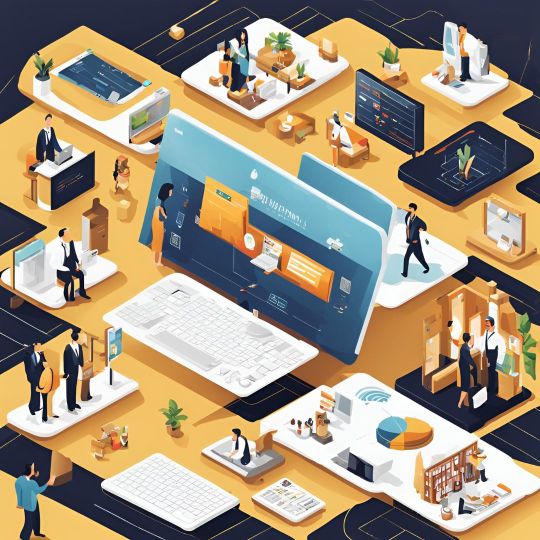
Ready to revolutionize your hotel management? Join the growing number of hospitality businesses transforming their operations with INNRLY.
Website: www.innrly.com
Email: [email protected]
Phone: 833-311-0777
#Innrly#Innrly Hotel Management Software#Bank Integrations in Hospitality Software#Tracking Hotel Compliance#hotel performance software#hotel portfolio software#Hotel Performance Management Software#hotel reconciliation software#Hotel Data Entry Software#accounting software hotels#hotel banking software#hospitality automated accounting software#hotel automation software hotel bookkeeping software#back office hotel accounting software#hospitality back office software#accounting hospitality software#Hotel Management Accounting Software#Hotel Accounting Software#Hospitality Accounting Software#Accounting Software for Hotels#Hotel Budgeting Software#Automate Night Audit Software#Automate Night Audit Process#Best Hotel Accounting Software#Best Accounting Software For Hotels#Financial & Hotel Accounting Software#Hospitality Accounting Solutions
2 notes
·
View notes
Text
Precium and the Evolution of Revenue Management: Why Rate Shopping & Automated Pricing Recommendations Are the Future of Hospitality
In today’s fast-paced world, the hospitality industry is experiencing a seismic shift. The days of managing hotel pricing with guesswork and gut feelings are long gone. Enter Precium, a sophisticated Automated Pricing Recommendation tool designed to help hoteliers maximize revenue, increase profitability, and stay ahead of the competition in an increasingly complex market.
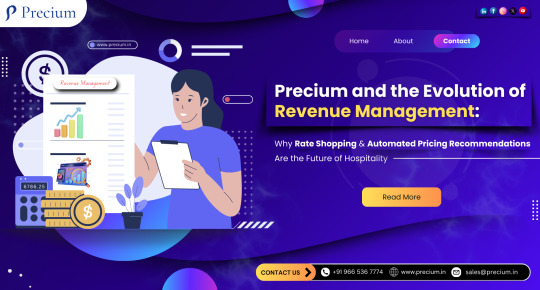
At the heart of Precium is a suite of Revenue Management Solutions that combine real-time data with powerful market insights. Whether you’re managing a boutique hotel, a mid-tier chain, or a luxury brand, Precium tools will revolutionize the way you approach pricing, revenue, and profitability.
But how exactly does Precium and its integrated rate shopping feature work? And why should you, as a hotelier, care about automated pricing recommendations? Let’s dive in.👇
The Shift from Traditional to Automated Revenue Management: A Need for Innovation
For decades, hotels have used traditional pricing strategies, relying on historical data, a few key demand drivers, and a bit of intuition to set room rates. However, this method often left substantial revenue potential untapped. Manual pricing, while reliable in its heyday, simply cannot keep up with the complexity of modern markets.
Today, technology is the beating heart of hospitality. With travellers booking rooms across various platforms, changing their preferences by the minute, and comparing rates at the click of a button, hoteliers need more agile solutions. This is where automated pricing comes into play, allowing for real-time adaptability.
The latest trends in Revenue Management Software now embrace automation, AI, and data science to deliver more accurate pricing strategies. These tools capture and analyse large volumes of data to recommend room rates that maximize revenue without alienating price-sensitive guests. Precium is at the forefront of this trend, using a combination of AI-driven insights and advanced algorithms to keep you one step ahead of your competitors.
👉Rate Shopping: The Secret Weapon for Staying Competitive
Before we talk about Precium Automated Pricing Recommendation, let’s explore rate shopping. It sounds like something your bargain-hunting aunt might do on Black Friday, but in the world of hotels, rate shopping is far more advanced.
In essence, rate shopping tools allow hotels to monitor the room prices of their competitors across a variety of booking channels. Want to know what the boutique hotel down the street is charging for a Deluxe Room? Curious about how your rates stack up against those of a 5-star competitor? Rate shopping tools can provide you with that real-time intel. This allows you to make strategic decisions on the fly, ensuring your prices are always competitive.
However, gathering that data manually would take hours, even days — time you simply don’t have. That’s why Precium automated rate shopping feature is a game-changer. It constantly monitors competitor pricing and feeds that information back into the system. In combination with Precium Automated Pricing Recommendation engine, it helps you adjust your rates with speed and precision, ensuring you never leave money on the table or lose out to undercutting competitors.
👉What is Automated Pricing Recommendation?
Picture this: It’s peak season, and your hotel is nearly at full capacity. Should you raise your rates? By how much? And how will this affect your booking pace? Or maybe it’s low season, and you need to fill as many rooms as possible without slashing your rates too dramatically.
This is where Precium Automated Pricing Recommendation tool comes in. Precium doesn’t just crunch numbers; it provides actionable insights. Powered by artificial intelligence, Precium analyses historical data, booking patterns, market trends, competitor pricing, and a host of other factors to suggest optimal room rates.
Think of it as a highly skilled revenue manager who never sleeps. It takes the guesswork out of pricing, allowing you to focus on what you do best — delivering top-notch guest experiences.
Why do you need this? Because setting the right price at the right time is the most critical driver of your hotel’s revenue. According to recent studies, hotels that use automated revenue management systems like Precium see up to a 10–15% increase in RevPAR (Revenue Per Available Room) compared to those relying solely on manual methods. It’s not magic; it’s math.
👉Revenue Management: Why It’s More Crucial Than Ever
It’s not just about the room rate anymore. Today’s revenue management strategies encompass all hotel revenue streams, including F&B, spa services, and ancillary offerings. The more sophisticated your approach, the better equipped you are to maximize your hotel’s total revenue potential.
With Precium, hoteliers have a comprehensive Revenue Management Solution. Whether you’re looking to forecast demand, adjust your pricing, or optimize your inventory, Precium does it all. By gathering data from multiple sources, Precium gives you a 360-degree view of your business, enabling you to implement revenue strategies that work in real time.
👉Latest Trends in Revenue Management Software: Where Precium Leads
As we look ahead, Revenue Management Software is evolving in three key ways:
🟢 AI and Machine Learning Integration: AI is becoming more integrated into Revenue Management Solutions, making systems smarter, faster, and more adaptable. Precium is already utilizing AI to deliver more accurate pricing recommendations based on live data and predictive analytics.
🟢Personalization: Guests expect personalized experiences, and the same goes for pricing. Precium can segment guests by demographics, booking behaviours, and preferences, allowing you to tailor pricing strategies for each market segment.
🟢Cloud-Based Solutions: The flexibility and scalability of cloud-based systems are unmatched. Precium offers cloud-based revenue management, enabling hoteliers to access their data from anywhere and scale their operations effortlessly.
These trends are not just innovations — they’re necessities in a competitive industry. Hotels that fail to adopt these technologies risk being left behind.
👉The ROI of Revenue Management: Why Investing in Precium Pays Off
Let’s be honest: Revenue Management Software is an investment, but it’s one that yields impressive returns. In fact, according to a recent study, hotels that implement automated revenue management systems see an average ROI of 7–12 months. After that, it’s pure profit.
With Precium Automated Pricing Recommendation, you don’t just set competitive prices — you set the right prices. It’s about understanding demand in real-time, responding to changes faster than your competitors, and ensuring every guest pays the optimal price.
👉Why You Need Precium Now
In an era where technology is revolutionizing every aspect of business, can you afford not to upgrade your revenue management system? Precium doesn’t just keep you competitive — it gives you a distinct advantage.
With rate shopping, automated pricing recommendations, and a team of experienced revenue managers behind it, Precium is the solution you need to boost your hotel’s profitability and stay ahead of the game.
Stop leaving money on the table. Let Precium help you unlock the full potential of your hotel’s revenue today.
✍Written by Mohnish Singh
#hospitality#redskyhospitality#hospitalityindustry#hotelrevenuemanagement#hotel#precium#preciumsoftware#software#RateShoppingSoftware#hotelrevenue
3 notes
·
View notes
Text
Hospital Management System| Hospital Management System Development Company in India
hospital management system company, hospital management system software development, best hospital management system websites, hospital management system,
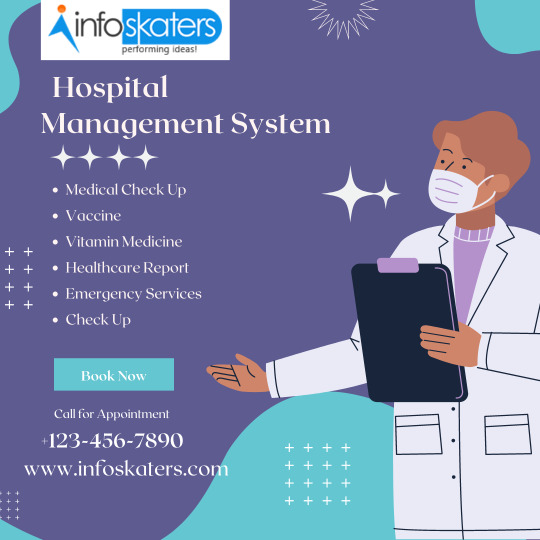
Smart Hospital consider a general scenario of typical hospital have different departments like OPD, IPD, Pharmacy, Pathology, Radiology, Operation Theatre, Blood Bank, Accounts, Admin etc. where we perform different patient and hospital related activities. Apart from above we also like to provide access to our Smart Hospital to different users like Doctors, Accountants, Pharmacist, Radiologist, Pathologist, and Patient. For these Smart Hospital have 9 inbuilt user's roles - Super Admin, Admin, Doctor, Accountant, Pathologist, Radiologist, Nurse, Receptionist and Patient. Virtually you can create unlimited number of user roles for staff members.
2 notes
·
View notes
Text
Revolutionizing Healthcare: The Role of Cloud Computing in Modern Healthcare Technologies
In today’s digital era, cloud computing is transforming industries, and healthcare is no exception. The integration of cloud computing healthcare technologies is reshaping patient care, medical research, and healthcare management. Let’s explore how cloud computing is revolutionizing healthcare and the benefits it brings.
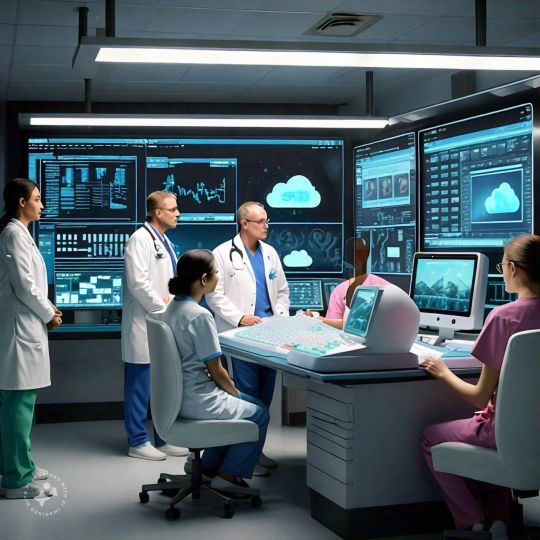
What is Cloud Computing in Healthcare?
Cloud computing in healthcare refers to the use of remote servers to store, manage, and process healthcare data, rather than relying on local servers or personal computers. This technology allows healthcare organizations to access vast amounts of data, collaborate with other institutions, and scale operations seamlessly.
Download PDF Brochure
Key Benefits of Cloud Computing in Healthcare
Enhanced Data Storage and Accessibility Cloud technology allows healthcare providers to store massive volumes of patient data, including medical records, images, and test results, securely. Clinicians can access this data from anywhere, ensuring that patient information is available for timely decision-making.
Improved Collaboration Cloud-based healthcare platforms enable easy sharing of patient data between healthcare providers, specialists, and labs. This facilitates better collaboration and more accurate diagnoses and treatment plans, especially in multi-disciplinary cases.
Cost Efficiency The cloud reduces the need for expensive hardware, software, and in-house IT teams. Healthcare providers only pay for the resources they use, making it a cost-effective solution. Additionally, the scalability of cloud systems ensures they can grow as healthcare organizations expand.
Better Data Security Protecting sensitive patient information is critical in healthcare. Cloud computing providers invest heavily in data security measures such as encryption, multi-factor authentication, and regular audits, ensuring compliance with regulatory standards like HIPAA.
Telemedicine and Remote Patient Monitoring Cloud computing powers telemedicine platforms, allowing patients to consult with doctors virtually, from the comfort of their homes. It also enables remote patient monitoring, where doctors can track patients' health metrics in real time, improving outcomes for chronic conditions.
Advanced Data Analytics The cloud supports the integration of advanced data analytics tools, including artificial intelligence (AI) and machine learning (ML), which can analyze large datasets to predict health trends, track disease outbreaks, and personalize treatment plans based on individual patient data.
Use Cases of Cloud Computing in Healthcare
Electronic Health Records (EHRs): Cloud-based EHRs allow healthcare providers to access and update patient records instantly, improving the quality of care.
Genomics and Precision Medicine: Cloud computing accelerates the processing of large datasets in genomics, supporting research and development in personalized medicine.
Hospital Information Systems (HIS): Cloud-powered HIS streamline hospital operations, from patient admissions to billing, improving efficiency.
Challenges in Cloud Computing for Healthcare
Despite its numerous benefits, there are challenges to implementing cloud computing in healthcare. These include:
Data Privacy Concerns: Although cloud providers offer robust security measures, healthcare organizations must ensure their systems are compliant with local and international regulations.
Integration with Legacy Systems: Many healthcare institutions still rely on outdated technology, making it challenging to integrate cloud solutions smoothly.
Staff Training: Healthcare professionals need adequate training to use cloud-based systems effectively.
Request Sample Pages
The Future of Cloud Computing in Healthcare
The future of healthcare will be increasingly cloud-centric. With advancements in AI, IoT, and big data analytics, cloud computing will continue to drive innovations in personalized medicine, population health management, and patient care. Additionally, with the growing trend of wearable devices and health apps, cloud computing will play a crucial role in integrating and managing data from diverse sources to provide a comprehensive view of patient health.
Conclusion
Cloud computing is not just a trend in healthcare; it is a transformative force driving the industry towards more efficient, secure, and patient-centric care. As healthcare organizations continue to adopt cloud technologies, we can expect to see improved patient outcomes, lower costs, and innovations that were once thought impossible.
Embracing cloud computing in healthcare is essential for any organization aiming to stay at the forefront of medical advancements and patient care.
Content Source:
2 notes
·
View notes